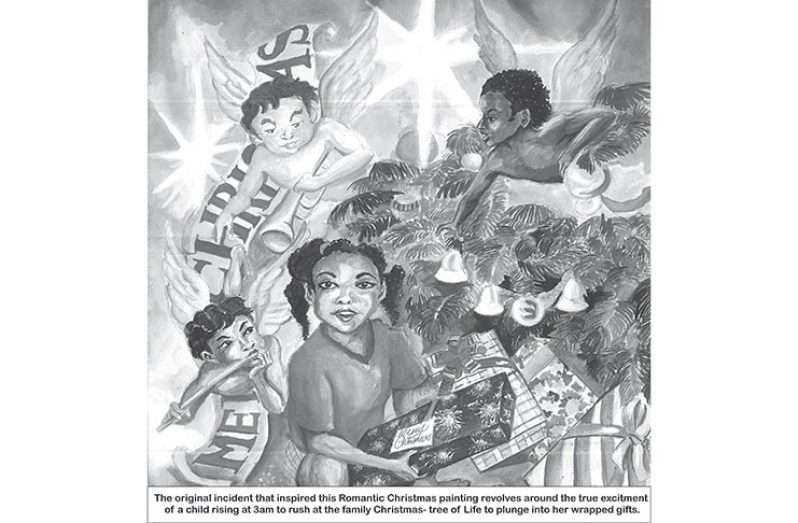WHOSE Holiday is Christmas? It’s not a religious question this time, because we all celebrate the intrinsic values that it captures, regardless of our religious backgrounds.And, whether we recognise it or not, the season is grounded in human harvest-renewal celebrations rooted in solstitial observations ancient to the religious events that are related to our Christmas.
The flashback that prompted this column occurred to me while walking through Sixth Street, Alberttown a few evenings ago. A group of pre-teens were excitedly gathered around the corner of a trench, and from the exchange, I realised that some creature was being killed; that the victims were either water snakes or frogs.
BOYHOOD DAYS
I intervened on behalf of the poor hapless creatures and succeeded in dispersing their tormentors, but for a moment my thoughts strayed to my childhood days in the countryside where, with the onset of the rainy season, such creatures abounded, and one could hear the crapaud choir among the ‘bizi-bizi’ grass or from the trenches round about.
And there was this one fellow who took pleasure in killing frogs and pelting cats and dogs; and the adults were always after him, scolding and making some pretty dark predictions about his future.
Then in his early young adult years, he went into the “gold bush”, and someone murdered him. The other side of the coin was the direction in which children were pointed back then around that season, which was a fun preoccupation and mind developing.
Children played ‘board’ games. The challenges of Draughts, Chinese Checkers and other games; card games like ‘rummy’ and ‘trip-trawl’, most likely local terms, were exciting family fun when not outdoors, pretending to be gun-slingers etc. Exciting, too, were those model kits that challenged close friends, and encouraged the nexus between plan reading and the juvenile engineer.
CHILDISH EXPECTATIONS
The life of Christmas revolves around the expectations of children. From the ancient world, there were celebrations that exalted the toy-maker; evidence of sculpted toys rests in the first dawn of our historical memory, throughout the human timeline, as well as children having their pet animals.
From a personal experience, living with my godparents, it meant a new pack of incredible toy soldiers, a ‘Cisco Kid’ cap gun and local leather holster. There was a lady in Stabroek Market who stocked this merchandise, made as real as any western movie replica, replete with with leather laces.
This menu was not quite fulfilled without the ‘boys annual’ of the day, be it TIGER, VALIANT or LION. Of course, they were designed for a Euro-centric audience. But compared to what? We enjoyed them.
The experience with playtime is sacred and unforgettable; neither my parents nor my godparents were rich or well-to-do folks, but they prioritised what was necessary, not entirely from an adult’s point of view, but from the perspective of bringing real joy to the young in their care.
And with my children and grand-child, I have tried to do the same. If we take the mundane interpretation of Christmas, it revolves around the birth of a special child.
THE CHRISTMAS STORY
In the Christmas story, children suffer; a child is saved; animals witness his birth; and Kings give him symbolic gifts.
Okay! So we’ve added on Dionysus and his bacchanal. The positive spin-off there is that there is much to eat and drink, and this at times eclipses the realm of the childhood rite of stimulation, which, if not embellished in its proper period may manifest later into darker cravings.
Books must be inclusive in gift giving; gift wrapping has a magic all of its own. These little things add up to the joy in young faces on Christmas Day, which young parents will find irritating if they purchase those battery-operated toys that keep noise throughout Christmas Day. I have learnt that from experience.
We in Guyana have not developed our children’s world; our politics is so exhausting that politicians seem to have forgotten or don’t know, from their own vacant childhoods, what children dream of.
We have seen the deprived child-play manifest into the darker cravings for excessive wealth, and to possess subordinate souls as toys.
Imagination is a tremendous ingredient for development. My daughter has a cat that has colonised her; I watch that cat and her mother play, as I watched puppies play in my childhood. Nature magazines and programmes cover the values of animals at play extensively.
As creatures of the animal world, we no less require that type of nurturing. Childhood can easily be narrowed down to the essential needs of housing, food and clothing, but if we teach children that that is all they need, they may very well grow up to become like politicians locally and worldwide who are being dragged daily before the courts for excesses, possibly to fill myriad empty spaces that have morphed into obsessions with abundant ownership for ownership sake.
SYMBOLISM
The Christmas symbolism is also decorated with a once German devil, remade and merged with the benevolent Saint Nicolas, the kindhearted Bishop from Myra [Turkey], whose alter ego is Krumpus the horned creature that predates Christianity, who carries away bad children.
Thus, we have Santa Claus and his African toymaker, the controversial Zwarte Piet (Black Peter).
From that combination, we are presented with the option to place the wager of good behaviour for the reward of gifts, as it is necessary to demonstrate to children that bad behaviour has regrettable consequences, a profound lesson that will be an essential guideline as they grow into adulthood, or we risk abdicating a crucial Christmas obligation, with far-reaching effects on the nature of the society we must strive to rebuild.
If re-interpreting Christmas can be a positive tool, and you didn’t realise it before, then 2016 is a good time to start.





.jpg)








